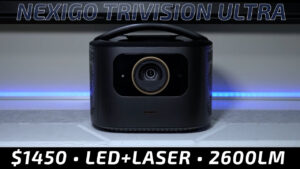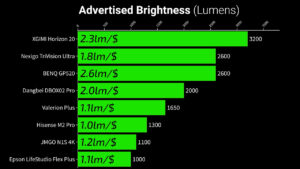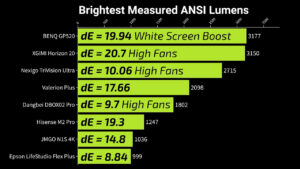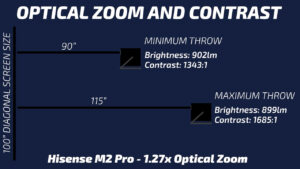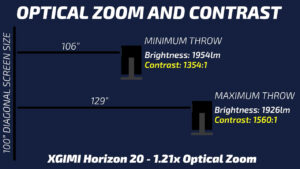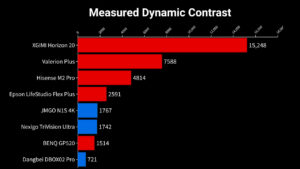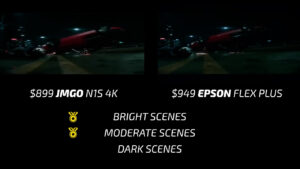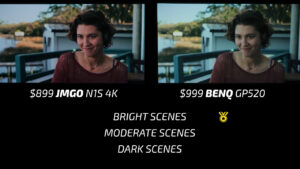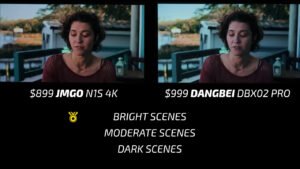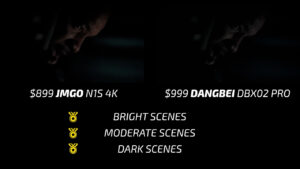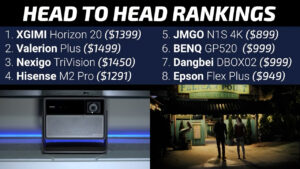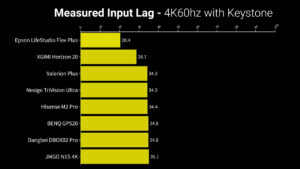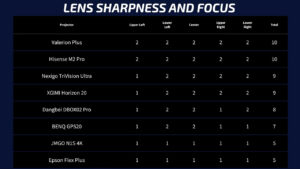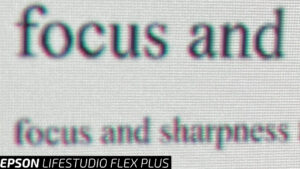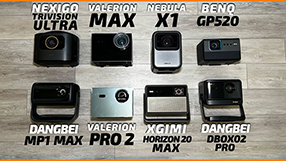Best Projectors Under $1500
November 6, 2025We’re getting close to wrapping up projector review season, but in this video, I’ve got what I think are the best projectors for most people which fall into the $900-1500 price range. That’s the current sweet spot where you can get surprisingly high performance and reliability that isn’t available in lower budget ranges without the diminishing returns of traditional high end home theater products. As always, there are no sponsored reviews on this channel, so let’s jump in.
Form Factors
Looking at their form factors, these eight projectors can be divided up into three basic groups.
First are the smaller projectors with built-in aiming solutions that would fit well on a bedside table. They are the $899 JMGO N1S 4K which is a triple laser DLP projector with an advertised brightness of 1100 lumens, the $949 Epson LifeStudio Flex Plus which is a single laser 3LCD projector with 1000 lumens of advertised brightness, and the $1291 Hisense M2 Pro which is a triple laser DLP like the JMGO, but adds optical zoom and 200 extra lumens with an advertised brightness of 1300 lumens.
Then you’ve got the larger projectors with built-in gimbal stands, which are much brighter. These include the $999 Dangbei DBOX02 Pro that has an advertised brightness of 2000 lumens using its dual laser light source and the $1399 XGIMI Horizon 20, a triple laser projector that not only has the highest advertised brightness by a significant margin at 3200 lumens, but it also has optical zoom and vertical and horizontal lens shift, which are absolutely unheard of at this price range.
Last are the projectors without built-in aiming solutions. These are the $999 BENQ GP520 which uses a 4LED light source to produce 2600 lumens of advertised brightness, the $1450 NexiGo TriVision Ultra which uses RGB lasers and RGB LEDs to produce its 2600 lumens of advertised brightness, and last, the most expensive projector in the video, is the $1499 Valerion StreamMaster Plus, which is a triple laser projector with an advertised brightness of 1650 ANSI lumens.
Brightness Testing
So, on paper, the XGIMI Horizon 20 is the brightest while the BENQ GP520 has the highest lumens per dollar, but step one of my testing is always to verify manufacturer brightness claims using the ANSI lumen standard where you take nine individual brightness readings, average them, and multiply by the screen size in square meters.
Using this method, the BENQ GP520 was actually the brightest, measuring 600 lumens higher than advertised at 3177 ANSI lumens, but it was unfortunately in a mode that no one would ever realistically use with a heavily green shifted image with an average color error of 19.94 when measured with Calman Ultimate which is really bad. Unfortunately, this was the case with nearly all these projectors and only the Epson was able to achieve its maximum brightness of 999 lumens in a mode you could actually use.
So instead, looking at their usable brightness which is their brightest mode with color error under 10 and fans running at normal speed, the NexiGo TriVision Ultra was the brightest at 2380 lumens in Vision Bright mode which does use a cooler color temperature, and the XGIMI Horizon 20 was just 7 measured lumens less than that at 2373 ANSI lumens in Movie mode with Luminance boost on which has a more traditional warmer color temperature and lower color error.
Contrast Testing
I also used a similar method to measure their native contrast, taking a center point brightness measurement on an all-white screen with a moving 50% gray box, and comparing it to the brightness of an all-black screen with the same moving 50% gray box. Using this method, the JMGO N1S 4K had the highest native contrast of 1767:1 followed closely by the much brighter NexiGo TriVision Ultra. Then the Hisense M2 Pro had a contrast ratio of 1685:1 when placed as far away from the screen as possible using its optical zoom while putting it at its minimum throw results in 18% less contrast. The XGIMI Horizon 20 loses about 13% of its contrast going from maximum throw to minimum.
I also measured their dynamic contrast which uses laser dimming during dark scenes to lower the black floor and the highest dynamic contrast came from the XGIMI Horizon 20 which measured a pretty insane 15,248:1 with the Valerion StreamMaster Plus in second place with about half of that at 7588:1. But dynamic contrast measurements should always be taken with a grain of salt because they don’t always translate into better picture quality. The only way to know for sure is to compare the projectors side by side, so I set up two 100” screens in a light-controlled space.
Head-to-Head Testing
Starting with the least expensive JMGO N1S 4K on the left and the Epson LifeStudio Flex Plus on the right. In bright scenes despite the JMGO and Epson having nearly the same measured brightness, the JMGO looks brighter and more vibrant due to its triple laser light source. There also appears to be significantly more depth and shadow detail, especially in Dani’s hair as a result of the fact that the JMGO has about three times the contrast of the Epson. The same was true in moderately lit scenes where the JMGO had excellent depth and shadow detail and the Epson looked dull, flat, and lifeless in comparison. In the darkest scenes where we would expect the Epson’s dynamic contrast to kick in, it was mostly still ineffective and blacks were muddy and dark gray rather than a true black. The Epson was also missing a significant amount of shadow detail, meaning this round was a clean sweep in all content types for the JMGO.
In round 2 the JMGO N1S 4K is on the left and the BENQ GP520 is on the right. With nearly twice the brightness and better color accuracy, the BENQ looked excellent in bright scenes. You can definitely notice the lack of contrast in Henry’s shirt and Dani’s hair, but overall, I thought the BENQ looked better in bright scenes. However, anytime there wasn’t daylight in a scene, the BENQ totally fell apart. Even with dynamic contrast enabled moderately lit scenes were washed out compared to the JMGO, and the darkest scenes on the BENQ were a total mess. While I do have some concerns about the JMGO’s color space in this scene from Obi-Wan Kenobi, it still easily won this round.
Round 3 has the JMGO N1S 4K on the left and the Dangbei DBOX02 Pro on the right. Unlike the previous round where the BENQ’s extra brightness and high color accuracy carried it in bright content, the Dangbei’s colors were not great, and Dani’s skin looked especially bad and was both pink and undersaturated. While the JMGO was definitely too red it still looked much better in comparison. In moderately lit scenes the Dangbei’s black floor and low native contrast made the image flat and uninteresting compared to the JMGO, which also gave the JMGO more perceived sharpness. Though again, you can tell the JMGO is significantly oversaturating reds, and in the darkest scenes it was no contest. The Dangbei looked muddy and gray and lost a significant amount of shadow detail, making this another easy win for the JMGO.
That means round 4 is the JMGO N1S 4K on the left and the Hisense M2 Pro on the right. In bright scenes the Hisense nailed the color accuracy and skin tones looked much more natural when compared with the red shifted JMGO. The 300 extra lumens gave it a bit more punch in the highlights, but in moderately lit scenes the dynamic laser dimming on the Hisense didn’t get a chance to kick in and the JMGO looked sharper and more interesting. However, in the darkest scenes when the Hisense’s dynamic dimming worked its magic, it managed to not only have a lower black floor than the JMGO but also kept more shadow detail intact. But the main reason that the Hisense won this round was that while the JMGO’s colors, especially red, looked more interesting and vibrant, they weren’t correct. The JMGO was using its native color space instead of the correct color space for the content, and while the Hisense has picture options to change from the correct color space to an incorrect one, the JMGO doesn’t have any options to make it correct, so the Hisense takes this round.
Round 5 then has the XGIMI Horizon 20 on the left and the Hisense M2 Pro on the right. The XGIMI is more than twice as bright as the Hisense. In the brightest scenes the XGIMI was nearly perfect with vibrant, accurate colors, and enough contrast to show shadow detail in dark areas like Henry’s shirt pocket and the small strands of Dani’s hair. In moderately lit content the XGIMI’s black floor was definitely higher, but the increased brightness of the highlights and intra-scene contrast gave the image much more depth and detail. Unfortunately, the dynamic contrast system on the XGIMI isn’t fixed yet and their dynamic black level enhancement setting turns the entire image purple any time the lasers are dimmed. However, because the overall brightness of the Horizon 20 is less than the Horizon 20 Max, the black floor without DBLE on isn’t unbearably high, and while I absolutely preferred the Hisense in the darkest scenes, I thought the XGIMI Horizon 20 was still tolerable in those scenes and was the clear winner in bright and moderately lit scenes, so the XGIMI won this round.
In round 6 the XGIMI Horizon 20 was on the left and the NexiGo TriVision Ultra was on the right. In the brightest scenes they were very close. Both had plenty of brightness and excellent color accuracy, but the Scene Adaptive Contrast system on the NexiGo was creating harsher shadows on Dani’s face than I would prefer. In moderately lit scenes the NexiGo was significantly raising the gamma, which can be nice for watching in imperfect environments, but was too bright for a dark room. Even though the NexiGo had better contrast and similar brightness on paper, the actual intra-scene contrast on the XGIMI seemed much higher with brighter highlights and darker shadows even without dynamic black level engaged. In the darkest scenes, neither of these projectors were particularly strong contenders with their high overall brightness and no effective laser dimming, but I thought the XGIMI was slightly better in these scenes as well, so it moved on again.
That means that in the final round the XGIMI Horizon 20 was on the left and the Valerion StreamMaster Plus was on the right. Starting with the brightest scenes both projectors looked great, but the extra brightness of the XGIMI was more eye catching, giving it a slight edge. The same was true in moderately lit scenes where the XGIMI’s 800 extra lumens made the highlights pop, resulting in a more exciting overall image, but in dark scenes it was absolutely no contest. The Valerion StreamMaster Plus has the same magic enhanced Black Level algorithms as its big brothers the VisionMaster Pro 2 and VisionMaster Max and using laser dimming, the Valerion was able to lower its black floor significantly while maintaining color accuracy and preserving highlight brightness. So, while the XGIMI is going to take this final round with a win in two out of the three viewing categories, the Valerion’s dark scene performance was substantially better.
That makes these the final rankings for viewing experience with the XGIMI Horizon 20 in 1st, the Valerion StreamMaster Plus in 2nd, the NexiGo TriVision Ultra in 3rd, and the Hisense M2 Pro in 4th.
Input Lag Testing
But there’s still plenty more to test, starting with input lag for gaming which is the time in between when you press a button on your controller and when you see the action on screen. In general input lag numbers under 20 ms are excellent for gaming, between 20-50 ms is fine for casual gaming, 50-100 ms is usable but not great, and over 100 ms shouldn’t be used for video games.
Starting with 4K resolution at 60 Hz which is what most people will use for gaming, all of the projectors except for the Dangbei and Epson were under 20 ms of input lag, and the XGIMI Horizon 20 was technically the lowest because I was measuring from the middle of the screen, but it’s using a new DLP controller that refreshes from the top of the screen down, so it can technically be as low as 2.7 ms if you measure from the top of the screen. The rest of the DLP projectors are the same no matter where on the screen you measure.
Next, I measured higher refresh rates for more serious gaming, and again the XGIMI came out on top when measuring from the middle of the screen. But the Valerion, Hisense and NexiGo also performed very well at these high refresh rates, while the BENQ, JMGO, Dangbei, and Epson all dropped frames and had unstable measurements for anything above 60 Hz.
Last, I measured their input lag at 4K60Hz while using digital keystone. In this test the Epson actually came out on top with just 20.7 ms of input lag, which is the same as when you aren’t using keystone, but I was surprised to see that all the projectors stayed under 50 ms, which is excellent considering keystoned input lag numbers were in the hundreds of milliseconds just two years ago.
Throw Ratio
Next, it’s time to talk about differences in their lens hardware, starting first with throw ratio which is how far away from the screen you’ll need to put your projector to get a specific screen size. All the projectors except the XGIMI Horizon 20 and Hisense M2 Pro have fixed throw ratios and require between 104” and 110” from the front of the projector to the screen to project a 100” diagonal screen, while the XGIMI can be placed anywhere from 106” to 129” away for a 100” screen due to its 1.2x optical zoom, and the Hisense M2 Pro can be much closer than that with a minimum throw distance of 90” and a maximum throw of 115” using its zoom.
Lens Quality
As I mentioned earlier in the video, the XGIMI Horizon 20 also includes both horizontal and vertical lens shift, which is unheard of at this price point and allows you to shift the entire image left or right, and up or down without compromising image quality and without the need for digital keystone which makes installation significantly easier and more flexible. In all of my testing, the XGIMI’s zoom and lens shift worked flawlessly.
To judge each projector’s lens focus, clarity, and sharpness, I projected this image and graded the middle and each corner of the screen from 0-2 with 0 being poor focus, 1 being average, and 2 being perfect focus. The only projector that I thought was noticeably terrible even from normal viewing distance was the Epson LifeStudio Flex Plus, which was so bad that I stopped halfway through the side-by-side testing to see if I could fix it, but it’s just not a sharp projector and to me looks slightly worse than 1080p despite Epson’s “4K PRO UHD” claims. The JMGO was also surprisingly bad and had decent focus, but poor rendering of the letters in the test pattern and looked to me like digital keystone was active even though it wasn’t. But other than those two, most of the other projectors had excellent focus. The Valerion StreamMaster Plus and Hisense M2 Pro both scored 10/10 while the NexiGo and XGIMI were just slightly soft in their upper left corners.
24p Motion
I also evaluated each projector’s ability to process and playback 24p cinematic motion using the extended horizontal pan from the intro of Ted Lasso Season 3 Episode 8 and the vertical pan from the intro of Foundation Season 3 Episode 9 and rated them on a scale from 1 to 10 based on their motion handling without MEMC. The projectors that did the best job converting from 24p to 60p without significant motion judder were the XGIMI Horizon 20, Valerion Plus, and JMGO N1S 4K. However, if you want to play back 24p content in true 24 frames per second, only the Valerion and NexiGo can do that at 4K resolution, while the XGIMI can do it at 1080p if you enable the projector super frame option. Of those three, the motion on the XGIMI during 24p content was by far the most cinematic despite its lower resolution.
3D Playback
Next, I judged the projectors 3D playback using the frame packed 3D Blu-ray of A Turtle’s Tale: Sammy’s Adventures and I rated each projector’s 3D in terms of eye comfort and 3D effect. There were no major standouts here, but the Hisense did seem to have a bit more 3D effect but less eye comfort while the BENQ GP520 was very comfortable but showed a slightly lower amount of depth. For me, both the NexiGo TriVision Ultra and XGIMI Horizon 20 were a nice middle ground between eye comfort and 3D effect but I do think I’m more sensitive than most when it comes to 3D eye fatigue.
DLP Rainbow Effect
Next, while on the subject of individual sensitivities, all these projectors except the Epson are single chip DLP projectors, which means they are susceptible to the DLP rainbow effect. All these projectors have pretty standard color orders with either 12 or 16 color flashes per frame. You can expect slightly less rainbow effect in the ones with 16 flashes, but if RBE is something you know you’re sensitive to, the Epson is the only one that won’t show any RBE at all since it uses a completely different projection technology.
Light Source Differences
Speaking of different projection technologies, the projectors in this video are about as diverse as possible in terms of their light sources, so here’s a quick breakdown of the light source of each projector and the strengths and weaknesses of each one. If you want a more in-depth explanation, here’s a link to an earlier review where I went much more in depth into color science.
Fan Noise
Next, looking at fan noise and speaker quality, here are the fan noise levels from quietest to loudest.
Speaker Quality
In terms of speaker quality, when playing a video with surround sound there was a massive difference in max volume. The JMGO and Dangbei were by far the quietest but still had decent frequency response. The Epson was also fairly quiet at 60.2 decibels but had a very balanced sound profile. The BENQ, Valerion, NexiGo, and XGIMI all had plenty of volume to fill a room, and the XGIMI also had excellent bass response from its built-in speakers. And the Hisense was extremely loud at 81.6 dB and had excellent vocal clarity but lacked the low-end response of the XGIMI.
Built-In Smart OS
Last, looking at their built-in operating systems, the majority of the projectors are using Google TV which has excellent app compatibility, but the Dangbei’s processor felt underpowered and sluggish inside of the Google TV interface. The Hisense M2 Pro uses VIDAA OS, which also has very good app compatibility and was very responsive, but may not be as familiar to you as Google TV. The NexiGo TriVision Ultra doesn’t include a built-in operating system at all and instead has a slot to add whatever streaming stick you want.
Conclusions
Now it’s conclusion time, and this is an easy one. There has never been a higher value projector than the XGIMI Horizon 20, period. It’s not even close. It had the highest usable brightness, finished first in the side-by-side testing, has the lowest input lag, excellent 3D, excellent 24p motion handling, the best speakers, a built-in gimbal stand, and optical zoom with vertical and horizontal lens shift. Tallying up the points, it was in first place by 9 points over the also excellent Valerion Plus, and that included giving the XGIMI a 1 for dynamic contrast since its DBLE option is basically unusable at this point. But XGIMI has promised a fix by Thanksgiving that could potentially make the Horizon 20 substantially better if it could actually utilize its over 15,000:1 dynamic contrast without color shifts or artifacts.
However, as of right now, if you’re looking for a projector for a light controlled theater room and your budget is $1500 or less, the Valerion StreamMaster Plus delivers the best image in terms of contrast and black level, While XGIMI’s DBLE system has the potential to match Valerion’s EBL, there isn’t currently any evidence that they’ve been able to do that, and EBL is still the best dynamic contrast system on the market by a significant margin. So, if you can position your projector properly to not need lens shift or zoom and you’d prefer extra contrast over extra brightness then the Valerion Plus should be your choice.
If you’re looking for a bedside projector to sit on a nightstand and project onto the wall or ceiling, the three obvious contenders are the JMGO N1S 4K, Hisense M2 Pro, and Epson LifeStudio Flex Plus. Of those three, the Hisense M2 Pro was by far the best, though the JMGO N1S 4K also did well, cost $400 less, and has slightly smaller overall dimensions but compared to the Hisense is lacking in terms of picture settings and speaker quality. It also doesn’t have optical zoom, which means it won’t be as flexible in placement as the Hisense, but both are excellent options, especially when compared to the Epson LifeStudio Flex Plus.
As always there are no sponsored reviews on this channel, but I do have links to all these projectors below and as always, I appreciate when you use those links since as an Amazon affiliate I do earn a small commission on the sale at no cost to you.
I’d also like to thank all of my awesome patrons over at Patreon for their continued support of my channel, and if you’re interested in supporting my channel please check out the links below. If you enjoyed this video, please consider subscribing to my YouTube channel and as always thanks for watching The Hook Up.
Highest Value (by far): XGIMI Horizon 20
Best for a Dedicated Home Theater: Valerion StreamMaster Plus
Best Bedside Table Projectors
- Hisense M2 Pro: https://amzn.to/4oiqLie
- JMGO N1S 4K: https://amzn.to/4qA4uhj
Other Projectors Tested
- NexiGo TriVision Ultra: https://amzn.to/3DHbhC6
- Dangbei DBOX02 Pro: https://amzn.to/4nxpQJj
- BENQ GP520: https://amzn.to/47tCOSv
- Epson LifeStudio Flex Plus: https://amzn.to/4nYr7Kh







